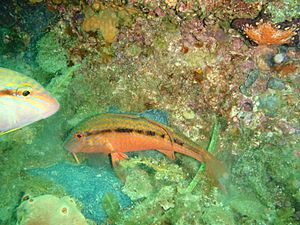Blue-spotted goatfish facts for kids
Quick facts for kids Blue-spotted goatfish |
|
|---|---|
 |
|
| Scientific classification | |
| Synonyms | |
|
The blue-spotted goatfish, also known as the southern goatfish, is a type of fish found in the ocean. It's a ray-finned fish from the Mullidae family, which are often called goatfishes. This fish lives along the coast of southern Australia.
Contents
What Does It Look Like?
The blue-spotted goatfish has a body that's fairly long and a bit flat from side to side. Its back curves steeply near its head. It has a long snout and small eyes. Its mouth is small with thick lips that don't reach its eyes.
This fish has two dorsal fins on its back. The first one is spiky and stands taller than the second, softer fin. It also has special whisker-like feelers called barbels on its chin. These barbels are about as long as its head.
The color of the blue-spotted goatfish can change a lot! It might be grayish-cream, light green, pink, or even orange-red. Many of these fish have a reddish or black stripe running along their sides, from their snout all the way to their tail. Adult fish have cool blue spots on their scales. At night, or when they feel stressed, they often turn a darker reddish color.
Where Does It Live?
You can find the blue-spotted goatfish all along the southern coast of Australia. It's quite common there! Its home stretches from southern Western Australia eastward across the southern Australian coast. It also lives around Tasmania and goes north along the east coast up to southern New South Wales.
Its Home and Habits
This fish likes to live in bays, estuaries (where rivers meet the sea), and calm coastal waters. It usually hangs out near reefs where the bottom is sandy or rocky. You can find it in water depths from about 2 to 200 meters (6 to 650 feet).
Young blue-spotted goatfish often swim together in groups in calm bays. Like other goatfishes, this species uses its chin barbels to search for food in the sand or mud. They mostly eat small crustaceans (like tiny crabs or shrimp). They also munch on some worms and sometimes even small fish.
Why Is It Important?
The blue-spotted goatfish is often caught by accident when people are fishing for other things. However, it's considered a tasty fish to eat, especially in South Australia.
How It Got Its Name
The blue-spotted goatfish was first described in 1829 by a scientist named Georges Cuvier. He originally named it Upeneus vlaminingii. The first place it was found and studied was King George Sound in Western Australia.
Cuvier named the fish after a Dutch explorer named Cornelis de Vlamingh. De Vlamingh explored Australia and drew pictures of fish for a museum in Paris. Cuvier used a copy of one of de Vlamingh's fish drawings to help him describe this new species.

